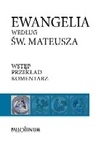
Żyjmy jak w jasny dzień
Na I niedzielę Adwentu roku A z cyklu „Wyzwania”
więcej »Starotestamentalne cytaty w Ewangelii Mateusza
Jest to fragment książki Ewangelia według św. Mateusza. Wstęp. Przekład. Komentarz :. Wydawnictwa Pallotinum
Racje te jednak są złożone, wieloaspektowe. Mateusz w zasadzie daje własną wersję tekstu biblijnego. Z chwilą jednak, gdy np. przekład grecki LXX był bilższy jego myśli, wówczas bez wahania z niego korzystał. Gdy znów dosłowne brzmienie TH bardziej odpowiadało jego intencjom, dawał przekład dosłowny. Prawie zawsze posługiwał się sensem wyrazowym W niektórych jednak przypadkach wolał uciekać się do sensu typicznego a nawet do akomodacji (np. 13,35). Był bowiem głęboko przekonany o ścisłej łączności obydwóch Przymierzy i dlatego usiłował o ile możliwości zawsze zwrócić łlwagę, jakie wydarzenia ST przedobrażały życie i czyny zbawcze Jezusa[20]. Ta teologiczna praca redakcyjna Mateusza uwidoczniła się w całej jego Ewangelii, zarówno w Ewangelii Dzieciństwa, jak również w opisie męki Jezusowej. Przede wszystkim zaś w opisie czynów i nauczania Jezusowego, czyli w tzw. części synoptycznej Ewangelii (rozdz. 3-25). U podstaw takiego właśnie redagowania narracji o Jezusie i Jego posłannictwie, tj. wkomponowania w tekst ewangeliczny tekstów ST tkwi niewątpliwie idea przepowiadania pojęta w sensie szerokim (por. Mt 28, 16-20; Mk 16, 15-18).
Bardzo dobitnie wyraził to Jan ewangelista w pierwszym zakończeniu swej Ewangelii: I wiele innych znaków, których nie zapisano w tej księdze, uczynił Jezus wobec uczniów. Te zaś napisano, abyście wierzyli, że Jezus jest Mesjaszem, Synem Bożym, i abyście wierząc mieli życie w imię Jego (20, 30-31).
-----------------------------------
Przypisy:
[1] Z bogatej bibliografii na ten temat należy wymienić następujące pozycje monograficzne: L. Venard, Citations de l'Ancien Testament dans le Nouveau Testament, DBS 2, 23-51; K. Stendahl, The School of St. Matthew and Its Use of the Old Testament (ASNU 20), Lund 1954 (19682); R.H. Gundry, The Use of the Old Testament in St. Matthew Gospel with Special Reference to the Messianic Hope (NovTestSupl 18), Leiden 1967; W. Rothfuchs, Die Erfüllungszitate des Matthäusevangeliums. Eine biblisch-theologische Untersuchung (BWANT 88), Stuttgart 1969; R.S. Mc Connell, Law and Prophecy in Matthew Gospel. The Authority and Use of the Old Testament in the Gospel of St. Matthew, Basel 1969; J.M. Efird, (ed), The Use of the Old Testament in the New and Other Essays. Studies in Honor of W. F. Stinespring, Durham 1972.
[2] Chodzi tu o wydanie krytyczne: The Greek New Testament, ed. by K. Aland, M. Black, B. M. Metzger. A. Wikgren, London 1966.
[3] Nazwa ta (Reflexionszitate) pochodzi od H. J. Holtzmanna (Die Synoptiker. Hand-Commentar zum Neuen Testament 1, Freiburg i. Br. 1889, 41). Egzegeta ten cytaty z inną formułą wprowadzającą niż: żeby się spełniło ... nazywa cytatami kontekstu (Contextzitate). Środowisko anglosaskie przyjęło od S.E. Johnsona (The Biblical Quotations in Matthew, HTR 36 [1943] 152) nazwą dla tych cytatów: formula quotationis. W. Rothfuchs (die Erfüllungszitate... dz. cyt. 20n) wprowadził nazwę: cytaty wypełnienia się (Erfüllungszitate). Podobnie F. van Segbroeck (Le scandal de l'incroyance. La signification de Mt. XIII, 35, EThL 41 [1965] 349).
[4] Por. F. van Segbroeck, Les citations d'accomplissement dans l'evangile selon Matthieu d'apres trois ouwaaes recents, w: Didier... 125-128; R.T. France, Jesus and the Old Testament. His Applications of OT Passages to Himself and His Mission, London 1971.
[5] Por. J.A. Fitzmyer, The Use of Explicit Old Testament Quotations in Qumran literature and in the New Testament, NTS 7 (1961) 299-305.
[6] Por. J.J. O'Rourke, The Fulfillment Text in Matthew, CBQ 24 (1962) 400-403; A. Baumstark, Die Zitate des Matthaus-Evangeliums aus dem Zwolfprophetenbuch, Bb 37 (1956) 296-313; N. Hi11yer, Matthew's Use of the Old Testament, EvQ 36 (1964) 12-25; R. Pesch, Eine alttestamentliche Ausführungsformel im Matthaus-Evangelium. Redaktionsgeschitliche und exegetische Beobachtungen, BZ 10 (1966) 220-245; 11 (1967) 79-85.
[7] Por. G. Danieli, L'inlfusso reciproco di tradizioni narratine e commenti profetici nel Vangelo di Mateo, DThP 71 (1968) 169-209.
[8] Zebrał je i omówił H. A. Kent, Matthew's Use of the Old Testament, BSc 121 (1964) 34-43.
[9] Por. W. Sollau, Unsere Evangelien, Leipzig 1901, 55-56; tenże, Zur Entstehung des I. Evangeliums, ZNW 1 (1900) 219-248.
[10] Por. B.W. Bacon, Studies in Mastthew, London 1930, 156-164. 470-476;
[11] Por. R.H. Gundry, The Use..., dz. cyt. 163-166.
[12] Por. B. Lindars, New Testament Apologetic. The Doctrinal Significance of the Old Testament Quotations, Philadelphia 1961, 148-159. 251-259: K. Stendahl, The School..., dz. cyt. 182-202.
[13] Por. R.H. Gundry, The Use..., dz. cyt. 172-178; J.A. Fitzmyer, The Languages of Palestine in the First Century A. D., CBQ 32 (1970) 501-531.
[14] Die Kairoer Genisa, Berlin 1962, 263-266.
[15] The Origins of the Gospel According to St. Matthew, Oxford 1946, 52-57. 93-95; zob. także: R.H. Gundry, The Use..., dz. cyt 153-155.
[16] Law and Prophecy..., dz. cyt. 101-143; zob. także F. van Segboroeck, Les citations..., art. cyt. 115-120.
[17] Die Erfüllungszitate..., dz. cyt. 27-56. 110-133: F. van Segbroeck, Les citations..., art. cyt. 120-128.
[18] Die Auseinandersetzung zwischen Kirche und Judentum im Matthäusevangelium (BEvTh 33), München 1963, 128-135.
[19] Scriptural Exegesis in the Gospel of St. Matthew and the Problem of Communication, w: Didier... 131-152.
[20] Por. H.A. Kent, art cyt. BSc 121 (1964) 34-43. Zob. także: M. Black, The Christological Use of the Old Testament in the New Testament, NTS 18 (1971) 1-14; J.A.E. van Dodewaard, La force evocatrice de la citation mise en lumiere en prenant pour base l'evangile de saint Matthieu, Bb 36 (1955) 482-491; E. Kutsch, Von der aktualität alttestamentlicher Aussagen für das Verständnis des Neuen Testaments, ZThK 74 (1977) 273-290; A. Sand, Das Gesetz und die Propheten: Untersuchungen zur Theologie des Evangehums nach Matthäus (Biblische Untersuchungen 11), Regensburg 1974.
aktualna ocena | |
głosujących | |
 Ocena |
bardzo słabe |
słabe |
średnie |
dobre |
super |
Ocena |
bardzo słabe |
słabe |
średnie |
dobre |
super |
Quizy
- Quiz: Historia biblijnych patriarchów
- Quiz: Jak dobrze pamiętasz biblijna prehistorię?
- Quiz wielkanocny
- Jak dobrze znasz Nowy Testament? (2)
- Jak dobrze znasz Stary Testement? (2)
- Quiz: Jak dobrze znasz Ewangelię Marka?
- Quiz: Jak dobrze znasz Stary Testament?
- Quiz: Czy znasz Nowy Testament?
- QUIZ: Co wiesz o Bożym Narodzeniu?






























